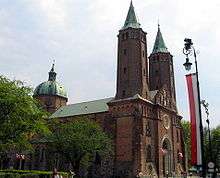Roman Catholic Diocese of Płock
The Roman Catholic Diocese of Płock (Latin: Plocen(sis)) is a diocese located in the city of Płock in the Ecclesiastical province of Warszawa in Poland.
Diocese of Płock Dioecesis Plocensis Diecezja Płocka | |
|---|---|
 | |
 Coat of arms | |
| Location | |
| Country | Poland |
| Ecclesiastical province | Warszawa |
| Metropolitan | Archdiocese of Warszawa |
| Statistics | |
| Area | 11,000 km2 (4,200 sq mi) |
| Population - Total - Catholics | (as of 2013) 793,367 780,899 (98.4%) |
| Information | |
| Rite | Latin Rite |
| Established | 1075 |
| Cathedral | Bazylika katedralna Wniebowzięcia Najświętszej Maryi Panny Cathedral of St. Mary of Masovia in Płock |
| Current leadership | |
| Pope | Francis |
| Bishop | Piotr Libera |
| Metropolitan Archbishop | Cardinal Kazimierz Nycz |
| Auxiliary Bishops | Mirosław Milewski |
| Map | |
 | |
| Website | |
| Website of the Diocese | |
Sunday mass attendance in 2013 was 30.7% of the population (39.1% Polish average) placing it to the group of less religious dioceses in the country.
History
- 1075: Established as Diocese of Płock[1]
- During the German occupation of Poland (World War II), the Archbishop of Płock Antoni Julian Nowowiejski and the auxiliary Bishop Leon Wetmański were imprisoned in the village of Słupno, and then in 1941 murdered in the Soldau concentration camp, where also many other priests from Płock were killed.[2] Nowowiejski and Wetmański are now considered two of the 108 Blessed Polish Martyrs of World War II by the Catholic Church. The Cathedral's ancient treasury, church archives and the diocesan library in Płock were robbed by the Germans, and taken to museums in Königsberg, Wrocław and Berlin.[3]
- 2018: Płock Cathedral along with the entire Wzgórze Tumskie ("Tumskie Hill") listed by the President of Poland as a Historic Monument of Poland.[4]
Special churches
Leadership
- Bishops of Płock (Roman rite)
- Archbishop Wojciech Baranowski (1591–1607)
- Archbishop Henryk Firlej (1617–1624)
- Bishop Jan Gembicki (1655.05.11 – 1674.03.13)
- Bishop Andrzej Chryzostom Załuski (1692.10.15 – 1699.05.25)
- Bishop Andrzej Stanisław Załuski (1723.11.22 – 1736.11.19)
- Bishop Antoni Sebastian Dembowski (1737–?)
- Bishop Józef Eustachy Szembek (1753–1758)
- Archbishop Michał Jerzy Poniatowski (1773–1784)
- Bishop Iraklij Listovskyj (1783 – 1809.08.30)
- Bishop Krzysztof Hilary Szembek (1784.10.02 – 1797.09.05)
- Bishop Ivan Krasovskyj (1809.09.22 – 1826)
- Bishop Tomasz Ostaszewski, S.J. (1815.09.04 – 1817.01.17)
- Bishop Adam Michał Prażmowski (1818–?)
- Archbishop Wincenty Teofil Popiel (1863.03.16 – 1875.07.05)
- Archbishop Franciszek Albin Symon (1897.07.21 – 1901.04.15)
- Archbishop Jerzy Józef Elizeusz Szembek (1901–1903)
- Archbishop Apollinary Wnukowski (1904.04.01 – 1908)
- Archbishop Antoni Julian Nowowiejski (1908.06.12 – 1941.05.28)
- Bishop Tadeusz Paweł Zakrzewski (1946.04.12 – 1961.11.26)
- Bishop Bogdan Sikorski (1964.01.21 – 1988.02.04)
- Archbishop Zygmunt Kamiński (1988.02.04 – 1999.05.01)
- Archbishop Stanisław Wielgus (1999.05.24 – 2006.12.06)
- Bishop Piotr Libera (since 2007.05.02)
gollark: Except a lot of them will be used to constant surveillance by parents, and also by that point governments and corporations.
gollark: According to a very trustworthy random internet article I happened to read yesterday, last century it was fairly common for young children to just be allowed to wander around outside on their own or with friends for ages.
gollark: To some extent, this is a modern trend.
gollark: Esolangs members are not reflective of the general population and if I had children I would not act this beeishly toward them.
gollark: Just in different ways.
See also
- Roman Catholicism in Poland
References
- Jerzy Kloczowski (2000). A History of Polish Christianity. Cambridge University Press. p. 15. ISBN 9780521364294. Retrieved August 9, 2016.
- Maria Wardzyńska, Był rok 1939. Operacja niemieckiej policji bezpieczeństwa w Polsce. Intelligenzaktion, IPN, Warszawa, 2009, p. 233 (in Polish)
- Wardzyńska, p. 224
- Rozporządzenie Prezydenta Rzeczypospolitej Polskiej z dnia 20 kwietnia 2018 r. w sprawie uznania za pomnik historii "Płock - Wzgórze Tumskie", Dz. U. z 2018 r. poz. 1003
This article is issued from Wikipedia. The text is licensed under Creative Commons - Attribution - Sharealike. Additional terms may apply for the media files.
